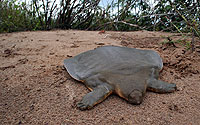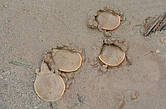tags: turtle, Cantor's giant softshell turtle, Pelochelys cantorii, endangered species, herpetology, reptiles
This photo released by Conservation International, shows two rare Cantor's giant
softshell turtles, Pelochelys cantorii, thought to be on the brink of extinction.
Conservation International and the World Wildlife Fund announced today, 16 May 2007,
that scientists discovered the rare species in Cambodia in a former stronghold of the
Khmer Rouge in March.
A rare soft-shell turtle has been found in Cambodia's Mekong River, raising hopes that the threatened species can be saved from extinction. Cantor's giant softshell turtle, Pelochelys cantorii (pictured), thought to be on the brink of extinction, was found in a former stronghold for the Khmer Rouge. This poorly-known species is one of the world's largest freshwater turtles.
An 11-kilogram (24 pound) female Cantor's giant turtle was captured and released by scientists in March, said the US-based groups, Conservation International (CI) and World Wildlife Fund (WWF). Scientists from the two groups, together with and Cambodian wildlife officials, discovered the animal along with a nesting ground while condusting a survey in Cambodia's Mekong River region. The team brought back eggs that have since hatched. The hatchlings were released into the wild on 8 May, together with another adult turtle and additional hatchlings captured by fishermen.
"We thought it might be almost gone, but found it in abundance in this one pristine stretch of the Mekong, making the area the world's most important site for saving this particular species," said David Emmett, a CI wildlife biologist.
"This incredible discovery means that a unique turtle can be saved from disappearing from our planet," he said.
The World Conservation Union currently classifies this turtle as endangered due to habitat loss and hunting.
 This turtle has a rubbery skin and its ribs are fused together to form a protective layer, or carapace, over its internal organs. It is olive-green in color. The species can grow up to 2 meters (6 feet) in length and weigh more than 50 kilograms (110 pounds). Despite its size, it spends up to 95 percent of its life hidden from predators in the sand with only its eyes and nose showing. An ambush predator, the turtle has long claws and can extend its neck with lightning speed and its jaws are powerful enough to crush bone.
This turtle has a rubbery skin and its ribs are fused together to form a protective layer, or carapace, over its internal organs. It is olive-green in color. The species can grow up to 2 meters (6 feet) in length and weigh more than 50 kilograms (110 pounds). Despite its size, it spends up to 95 percent of its life hidden from predators in the sand with only its eyes and nose showing. An ambush predator, the turtle has long claws and can extend its neck with lightning speed and its jaws are powerful enough to crush bone.
"It has the fastest strike of any animal I've ever seen, including cobras," Emmett added.
 The portion of the Mekong River where the turtle was found is a pristine region that has been closed for many years to scientific exploration because it was one of the last strongholds of the former Khmer Rouge regime in Cambodia. This recent survey was the first detailed study of the area since security restrictions were relaxed in the late 1990s.
The portion of the Mekong River where the turtle was found is a pristine region that has been closed for many years to scientific exploration because it was one of the last strongholds of the former Khmer Rouge regime in Cambodia. This recent survey was the first detailed study of the area since security restrictions were relaxed in the late 1990s.
"Our survey work to date has documented some of the highest freshwater biodiversity values in the entire Lower Mekong Basin," said Mark Bezuijen of WWF's Living Mekong Program, who led the team. "We discovered an entirely new plant species, Amorphophallus sp., along with surviving populations of such threatened species as terns, fish eagles, green peafowl, otters, and silvered leaf-monkeys. More than 180 fish species were recorded, a new record for Cambodia."
Conservation officials plan to hire local villagers to protect the turtle's nesting beaches and to conduct patrols during the dry season to prevent illegal fishing of the species, which is prized as an expensive delicacy in neighboring Vietnam. The villagers also will receive financial incentives to offset the potential loss of revenue from illegal trade in the turtles, WWF said.
Even though this turtle is found in small numbers in Laos, it appears to have disappeared entirely from Viet Nam and Thailand. It was last seen in the Cambodian wild in 2003 by scientists.
Sources
CI press release (quotes, image)
WWF press release (quotes, image)


Am I the only one looking at the photos thinking that they survived by lying very flat?
Bob
They really are odd-looking...still, I'm glad they'll be protected. The field diary of David Emmett, one of the scientists, is really fascinating--it's on the CI website...which seems to be mixed up with WWF in the links above. Anyway, I love the phrase "best reptile night ever"
http://www.conservation.org/xp/frontlines/2007/05160701.xml
Two Pelochelys cantorii were washed ashore in Malaysia within 2 months towards the end of 2006, and I blogged about it here and here.
We also conducted a post-mortem (though we didn't know what to expect since none of us had proper trainings) on the first Pelochelys that we found (I have some pictures in my Flickr).
It's good that they've involved locals in their protection, but I'm still not exactly sanguine about their chances. I still think that many of them are going to end up as food for humans, protected/endangered or not.